IOS开发之——数据库-常见操作(02)
一 概述
- SQL语句
- SQL表格操作
- SQL数据操作
二 SQL语句
2.1 SQL语句
什么是SQL
- SQL(structured query language):结构化查询语言
- SQL是一种对关系型数据库中的数据进行定义和操作的语言
- SQL语言简洁,语法简单,好学好用
什么是SQL语句
- 使用SQL语言编写出来的句子\代码,就是SQL语句
- 在程序运行过程中,要想操作(增删改查,CRUD)数据库中的数据,必须使用SQL语句
SQL语句的特点
- 不区分大小写(比如数据库认为user和UsEr是一样的)
- 每条语句都必须以分号 ; 结尾
- 数据库中不可以使用关键字来命名表、字段
SQL中的常用关键字
1 | select、insert、update、delete、from、create、where、desc、order、by、group、table、alter、view、index等等 |
2.2 SQL语句的种类
数据定义语句(DDL:Data Definition Language)
- 包括create和drop等操作
- 在数据库中创建新表或删除表(create table或 drop table)
数据操作语句(DML:Data Manipulation Language
- 包括insert、update、delete等操作
- 上面的3种操作分别用于添加、修改、删除表中的数据
数据查询语句(DQL:Data Query Language)
- 可以用于查询获得表中的数据
- 关键字select是DQL(也是所有SQL)用得最多的操作
- 其他DQL常用的关键字有where,order by,group by和having
三 SQL表格操作
本文介绍利用SQL语句创建表格和删除表格
3.1 创建表格
格式
1 | create table 表名 (字段名1 字段类型1, 字段名2 字段类型2, …) ; |
说明:
通过此方式创建表格,如果表格不存在则创建,存在则不再创建
SQLite将数据划分为以下几种存储类型:integer : 整型值、real : 浮点值、text : 文本字符串、blob : 二进制数据(比如文件)
实际上SQLite是无类型的,建表时声明啥类型或者不声明类型都可以,也就意味着创表语句可以这么写
1
create table t_student(name, age);
示例
1 | create table t_student (id integer, name text, age inetger, score real) ; |
操作过程
在表格或Queries上右键,选择New Query
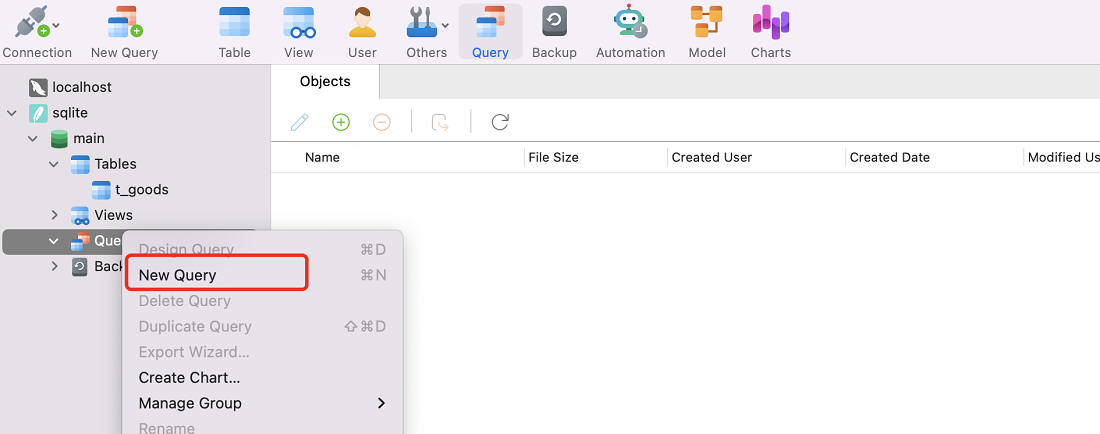
在文本框中输入示例语句

点击run,执行表格创建语句,效果图如下(底部显示创建结果,Tables刷新后显示表格)
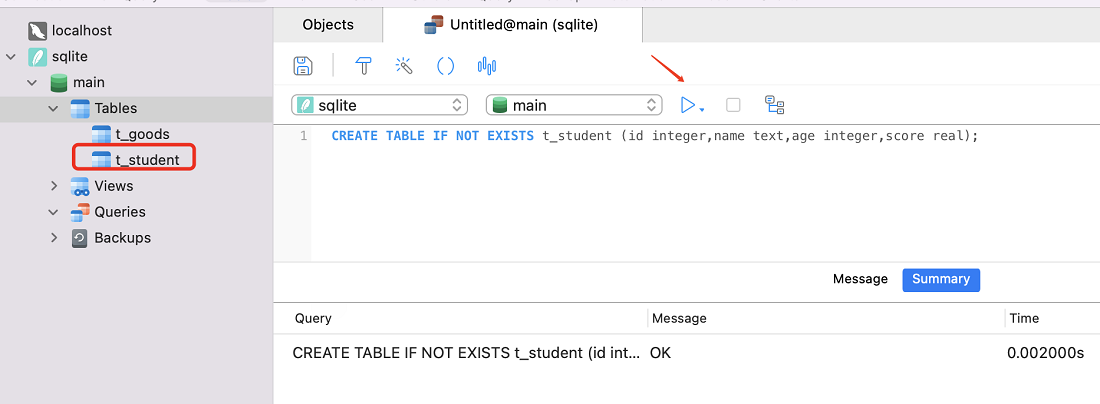
3.2 删除表格
格式
1 | drop table 表名 ; |
示例
1 | drop table if EXISTS t_student; |
操作过程
同理,在New Query打开的窗口中,执行示例,删除表格

四 SQL数据操作
本文介绍的数据操作有:插入数据(insert)、更新数据(update)、删除数据(delete)、查询语句(select)、条件语句(where)、起别名、计算记录数量(count)、排序(order by)、分页查询(limit)、字段属性约束(not null、unique、default)、主键约束(primary key)、外键约束(foreign key)、表连接查询(内连接、外连接)
4.1 插入数据(insert)
格式
1 | insert into 表名 (字段1, 字段2, …) values (字段1的值, 字段2的值, …) ; |
示例(字符串用单引号)
1 | INSERT INTO t_student(id,name,age,score) VALUES(1,'李四',18,60.0); |
操作过程
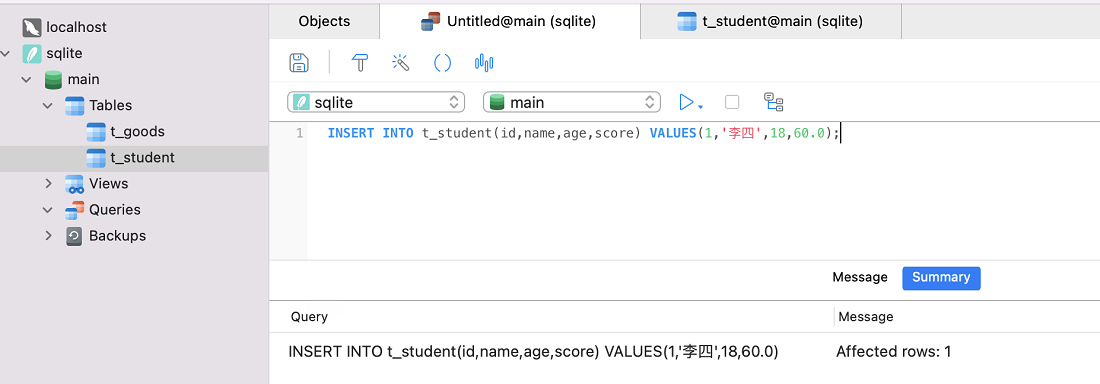
4.2 更新数据(update)
格式
1 | update 表名 set 字段1 = 字段1的值, 字段2 = 字段2的值, … ; |
示例(设置多个字段,用逗号连接)
1 | update t_student set name='张三',age=20; |
操作过程
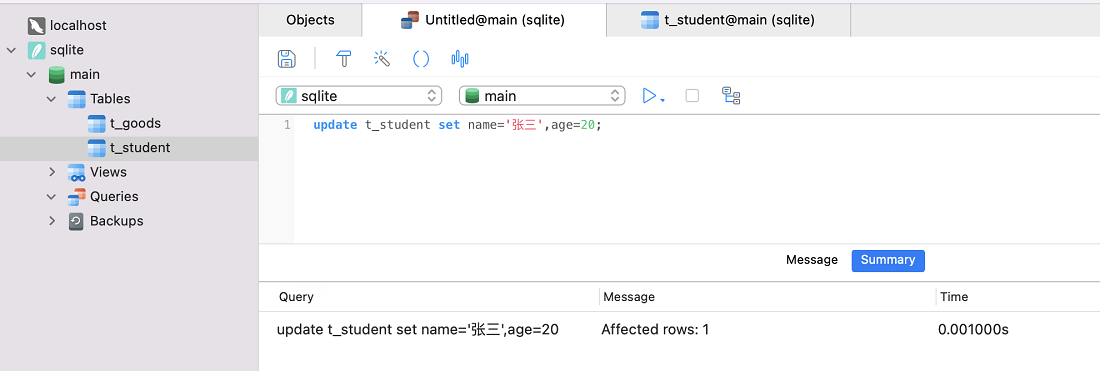
4.3 删除表格(delete)
格式
1 | delete from 表名 ; |
示例(删除表格记录,不是表格本身)
1 | delete from t_student; |
操作过程

4.4 查询语句(select)
格式
1 | select 字段1, 字段2, … from 表名 ; |
示例
1 | select name,age from t_student; |
操作过程
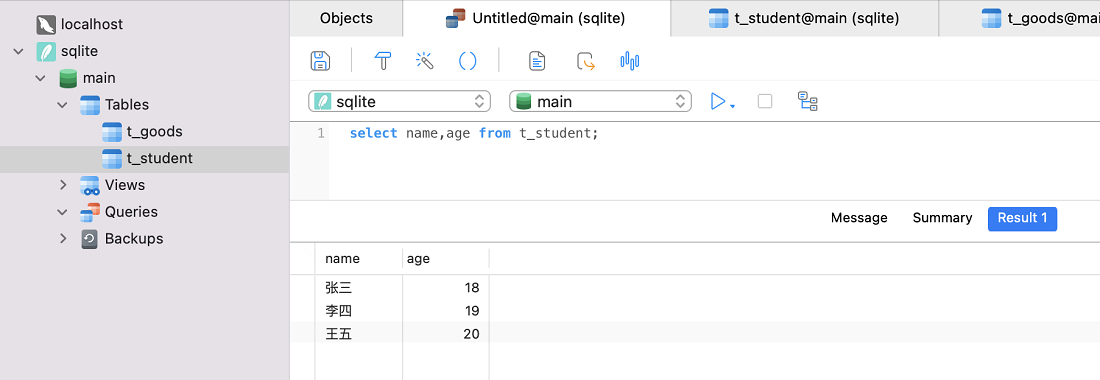
4.5 条件语句(where)
如果只想更新或者删除某些固定的记录,那就必须在DML语句后加上一些条件
条件语句的常见格式
1 | where 字段 = 某个值 ; // 不能用两个 = |
示例
1 | 将t_student表中年龄大于10 并且 姓名不等于jack的记录,年龄都改为 5 |
操作过程

4.6 起别名
格式
格式(字段和表都可以起别名)
1 | select 字段1 别名 , 字段2 别名 , … from 表名 别名 ; |
示例
1 | select name myname, age myage from t_student ; |
操作过程
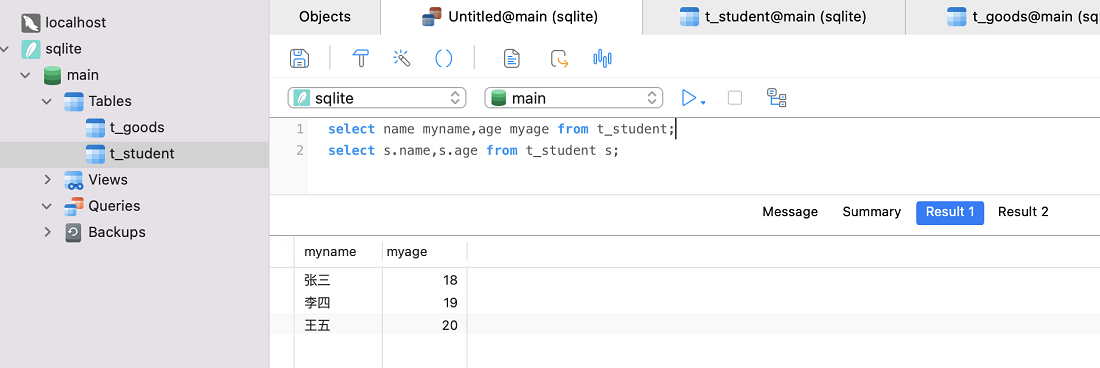
4.7 计算记录数量(count)
格式
1 | select count (字段) from 表名 ; |
示例
1 | select count (age) from t_student ; |
操作过程

4.8 排序(order by)
格式
1 | 查询出来的结果可以用order by进行排序 |
示例
1 | select * from t_student order by score desc,age asc; |
操作过程
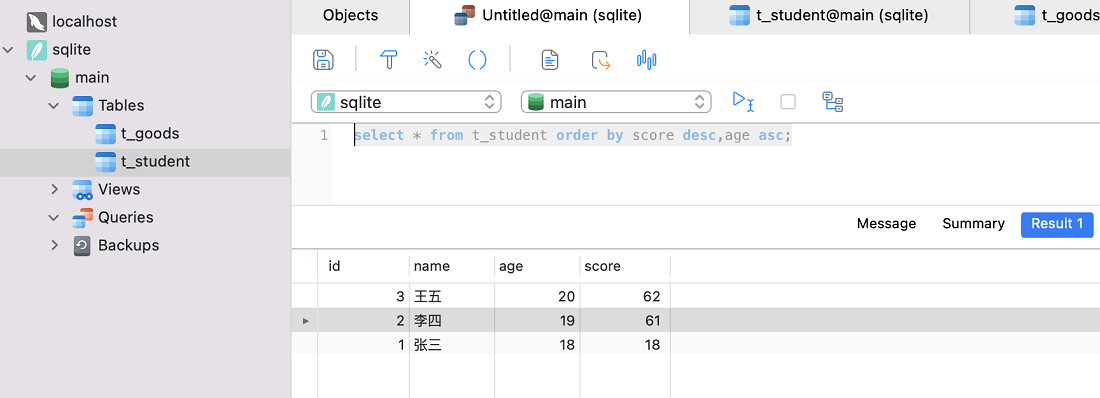
4.9 分页查询(limit)
使用limit可以精确地控制查询结果的数量,比如每次只查询10条数据
格式
1 | select * from 表名 limit 数值1, 数值2 ; |
示例(跳过最前面4条语句,然后取8条记录)
1 | select * from t_student limit 4, 8 ; |
limit后面只有一个数值
1 | select * from t_student limit 7 ; |
4.10 字段属性约束(not null、unique、default)
约束说明
建表时可以给特定的字段设置一些约束条件,常见的约束有
1 | not null :规定字段的值不能为null |
示例(name字段不能为null,并且唯一,age字段不能为null,并且默认为18)
1 | create table if not exists t_student(id integer,name text not null unique,age integer not null default 18,score real); |
操作过程

4.11 主键约束(primary key)
什么是主键
- 主键(Primary Key,简称PK)用来唯一地标识某一条记录
- 例如t_student可以增加一个id字段作为主键,相当于人的身份证
- 主键可以是一个字段或多个字段
主键的设计原则
- 主键应当是对用户没有意义的
- 永远也不要更新主键
- 主键不应包含动态变化的数据
- 主键应当由计算机自动生成
示例
在创表的时候用primary key声明一个主键
1 | create table if not exists t_student (id integer primary key autoincrement, name text, age integer,score real) ; |
操作过程

4.12 外键约束(foreign key)
外键说明
- 利用外键约束可以用来建立表与表之间的联系
- 外键的一般情况是:一张表的某个字段,引用着另一张表的主键字段
外键操作
创建表t_class

创建t_student的属性

指定t_student的class外键(选中class后,点击Foreign Keys,设置Name(外键名),Referenced Table(关联表),Referenced Fields(关联字段)、Local Fields(本表字段))
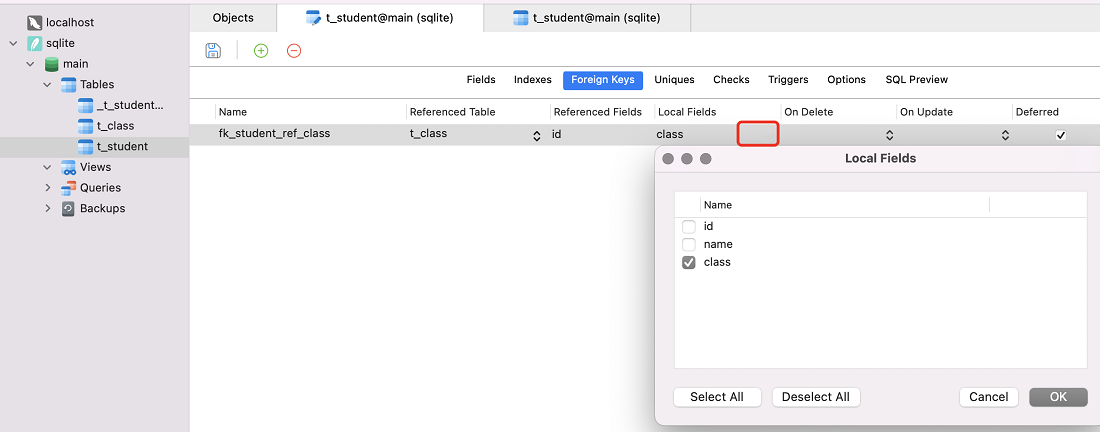
给t_class设置记录

t_student的class选项只有1,2,3
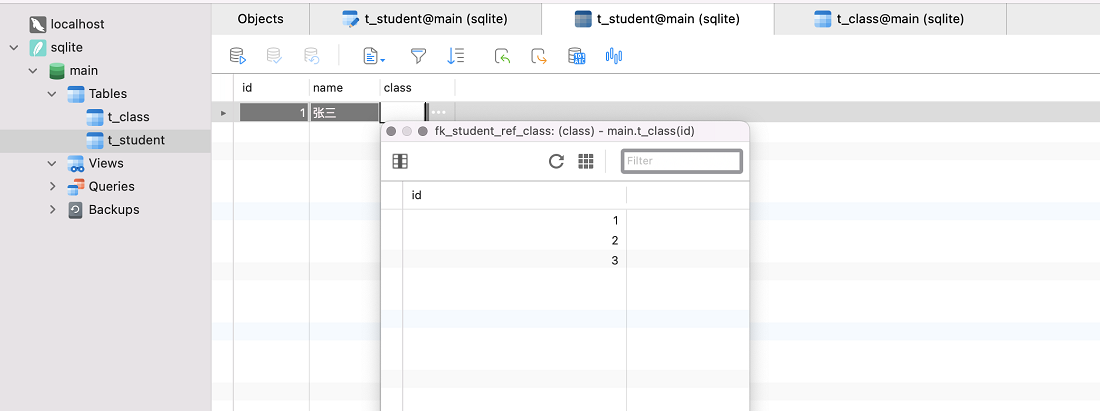
t_student的DDL
1 | CREATE TABLE "t_student" ( |
4.13 表连接查询(内连接、外连接)
什么是表连接查询
需要联合多张表才能查到想要的数据
表连接的类型
- 内连接:inner join 或者 join (显示的是左右表都有完整字段值的记录)
- 左外连接:left outer join (保证左表数据的完整性)
示例
1 | select s.name from t_student s, t_class c where s.id = c.id and c.name = '语文'; |
操作
| t_student | t_class | 关联查询结果 |
|---|---|---|
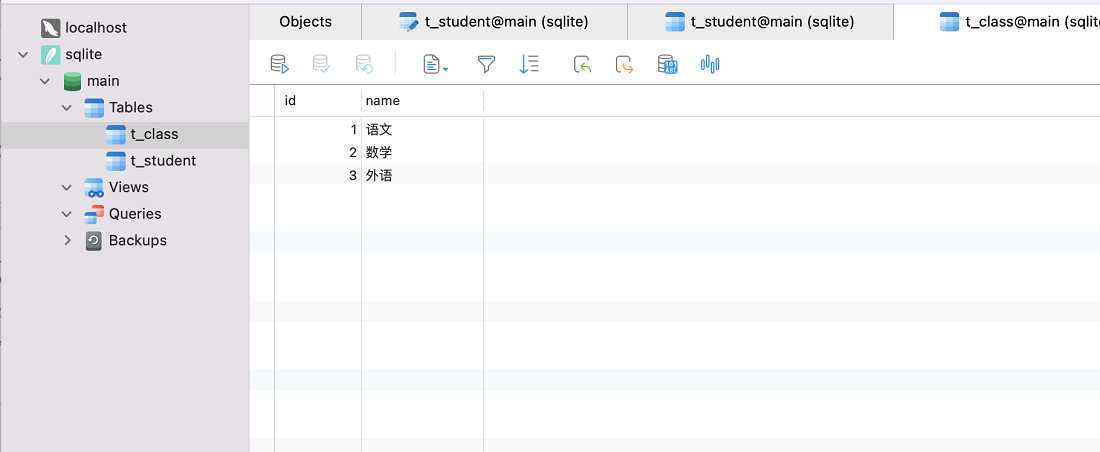 |
 |
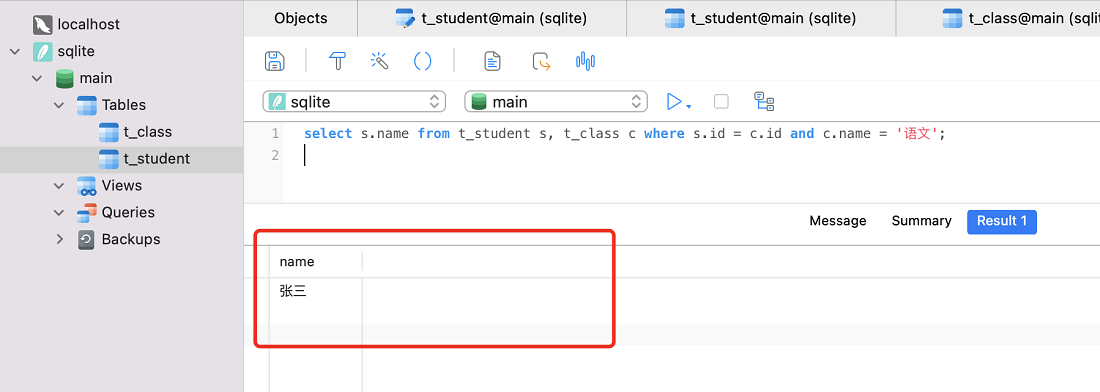 |